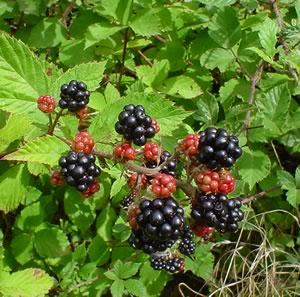
Rubus is a large and diverse genus of flowering plants in the rose family, Rosaceae, subfamily Rosoideae, with over 1,350 species.
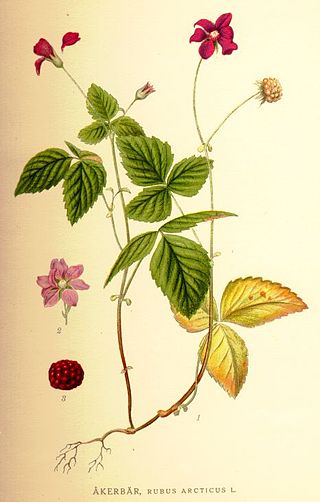
Rubus arcticus, the Arctic bramble or Arctic raspberry, is a species of slow-growing bramble belonging to the rose family, found in arctic and alpine regions in the Northern Hemisphere.

Rubus saxatilis, or stone bramble, is a species of bramble widespread across Europe and Asia from Iceland and Spain east as far as China. It has also been found in Greenland.
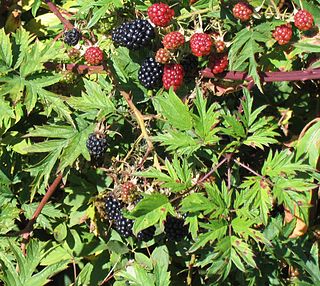
Rubus laciniatus, the cutleaf evergreen blackberry or evergreen blackberry, is a species of Rubus, native to Eurasia. It is an introduced species in Australia and North America. It has become a weed and invasive species in forested habitats in the United States and Canada, particularly in the Northeast and along the Pacific Coast.

Rubus parvifolius, called Japanese bramble, or Australian raspberry in the United States or native raspberry in Australia is a species of plant in the rose family. It is a scrambling shrub native to eastern Asia and Australia. It has also become naturalized in a few scattered locations in the United States.

Rubus pedatus is an Asian and North American species of raspberry known under the common names five-leaved bramble, strawberryleaf raspberry and creeping raspberry.

Rubus argutus is a North American species of prickly bramble in the rose family. It is a perennial plant native to the eastern and south-central United States. Common names are sawtooth blackberry or tall blackberry after its high growth.
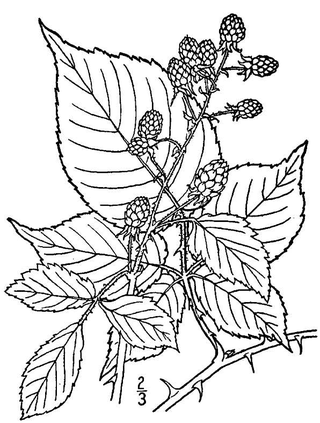
Rubus allegheniensis is a North American species of highbush blackberry in section Alleghenienses of the genus Rubus, a member of the rose family. It is the most common and widespread highbush blackberry in eastern and central North America. It is commonly known as Allegheny blackberry.

Rubus vestitus is a European species of brambles in the rose family, called European blackberry in the United States. It is native to Europe and naturalized along the northern Pacific Coast of the United States and Canada.
Rubus bushii, common name Bush's blackberry, is a rare North American species of flowering plant in the rose family. It has been found only in the central United States.

Rubus cuneifolius, the sand blackberry, is a North American species of flowering plant in the rose family. It occurs in the eastern United States in every coastal state from Louisiana to New Hampshire, with the exception of Rhode Island. There are also reports of inland populations in Tennessee, Arkansas, and Oklahoma, and the species has become an invasive species in South Africa.
Rubus plicatifolius is a North American species of dewberry in the rose family. It is found in eastern and central Canada and in the eastern and central United States.
Rubus roribaccus a North American species of brambles in the rose family, called the Lucretia blackberry. It grows in eastern Canada (Québec) and the eastern and central United States.
Rubus tomentosus is a European and Middle Eastern species of brambles in the rose family. It grows in southern and central Europe and in southwestern Asia from Portugal to Iran, north as far as Germany, Poland, and Ukraine. There are a few reports of the species sparingly naturalized in the State of West Virginia in the eastern United States.
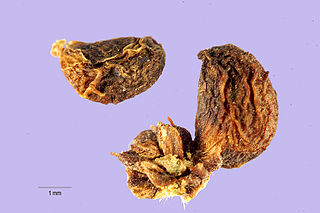
Rubus macrophyllus is a European species of bramble in the rose family. It can be found across Europe, from Ireland to Bulgaria. There are reports of the species having become naturalized in the States of Washington and Oregon in the northwestern United States.
Rubus steelei is an uncommon North American species of brambles in the rose family. It grows only in the United States, primarily in the upper Mississippi Valley, the Great Lakes region and the Appalachian Mountains, with isolated populations scattered in Texas, Georgia, and Alabama.
Rubus leviculus is a rare North American species of brambles in the rose family. It has been found only in scattered locations in the eastern and central United States.
Rubus kelloggii is a rare North American species of brambles in the rose family. It has been found only in the state of Missouri in central United States.
Rubus nefrens is a rare North American species of brambles in the rose family. It has been found in scattered locations in the central United States, in Missouri, Iowa, Kentucky, and Ohio. Nowhere is it very common.
Rubus pascuus is an uncommon North American species of brambles in the rose family. It grows only in the United States, primarily in the Ozarks of Missouri and Arkansas but with scattered populations farther east in New Jersey, Maryland, Virginia, and the Carolinas.










